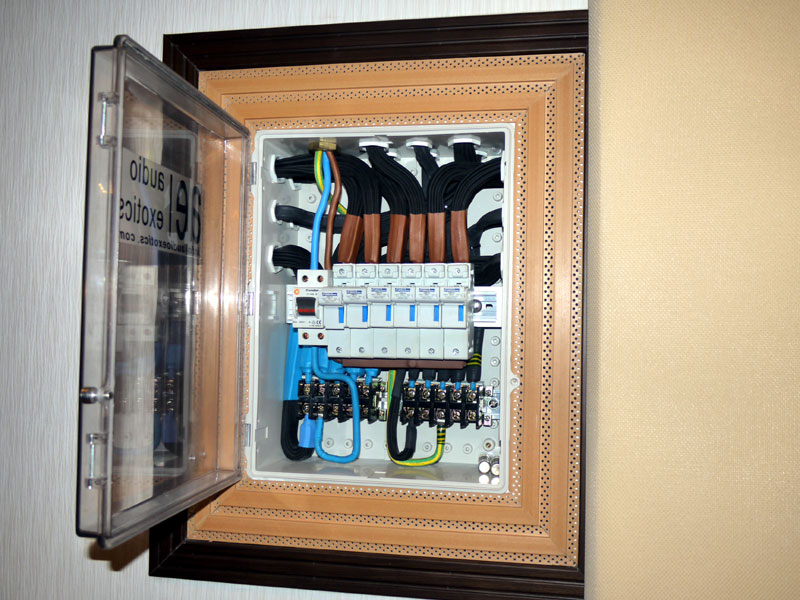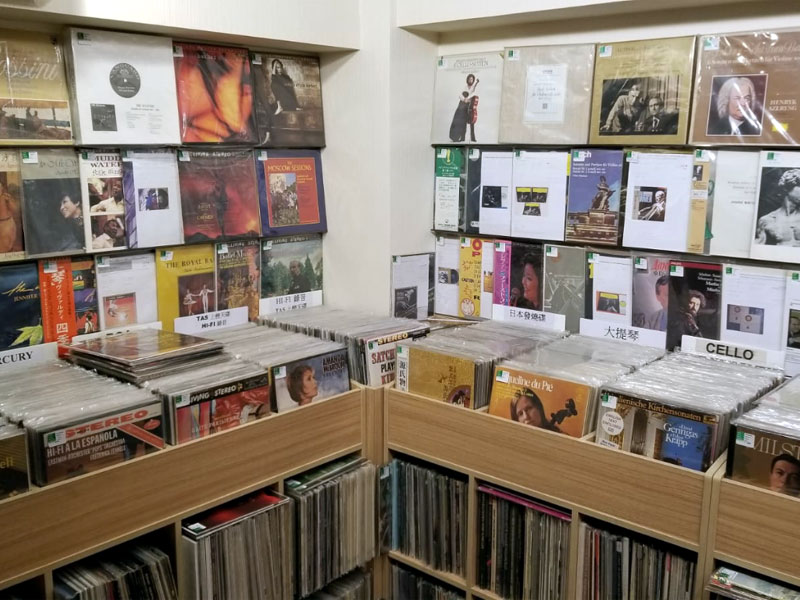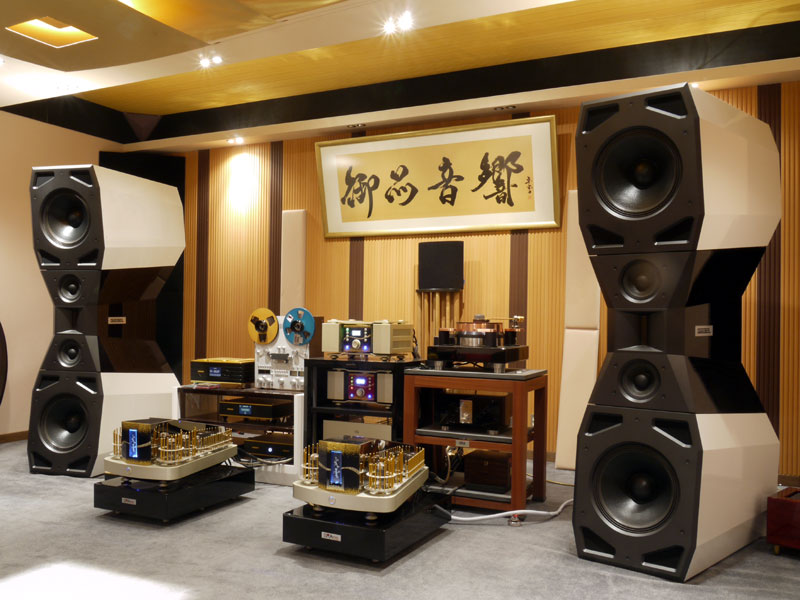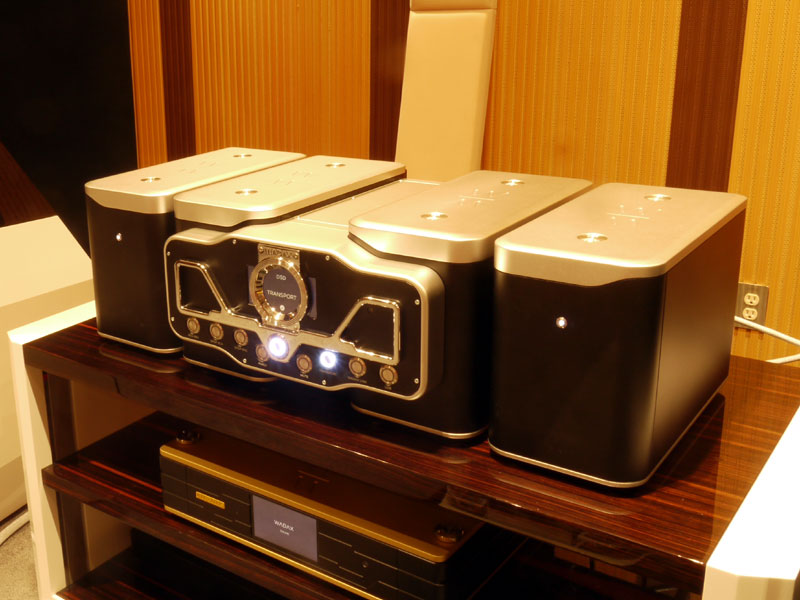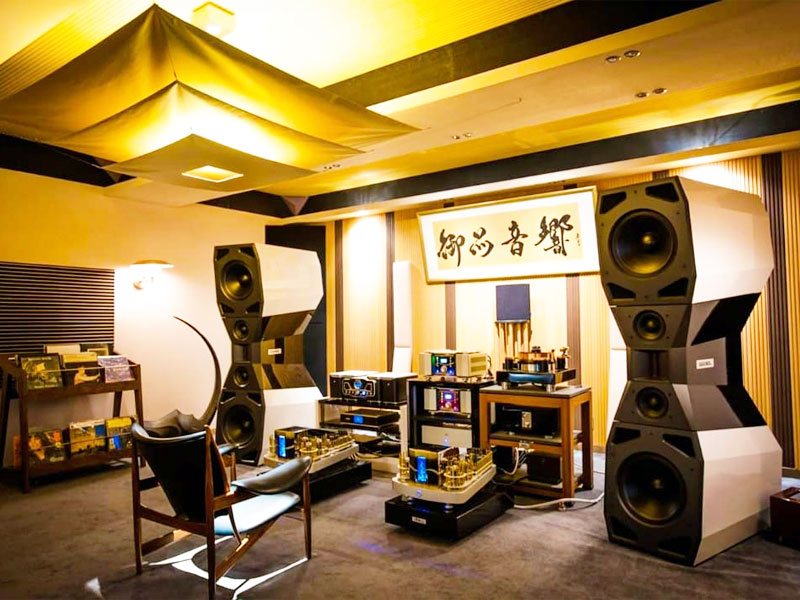The Times They Are A-Changin': Audio Exotics Hong Kong
ne of the most interesting parts of reporting on high-end audio is the sheer range of individuals and characters you get to meet. But as varied as they are, not so long ago you could clearly categorize them in terms of their positions within the industry and market. These days, those distinctions are becoming increasingly blurred, with customers becoming importers, dealers becoming distributors, and anybody who fancies the press joining it. Good advice (and good practice) is becoming increasingly hard to find. The result is chaotic -- and chaos has never been good for business or performance. Time, then, to meet a man on a mission, a man with a vision and a model for the audio industry; time to meet Chris Leung of Audio Exotics, a Hong Kong distributor who does things distinctly differently.
Chris Leung of Audio Exotics. But first, let’s take a moment to figure out just how we got here. For many years, the high-end audio industry had an accepted, stable structure, with manufacturers working through distributors and dealers to service customers. It was an arrangement that defined more than simply who delivered your loudspeakers, impacting on price structures, warranty arrangements, and national/international sales strategies. As the industry became truly global, price parity and the definition/protection of sales areas became as important as musical performance in a brand’s struggle to succeed. The first cracks in the edifice started to appear with the advent of the Internet. With greater and easier access to price information and international suppliers, both customers and dealers started looking further afield in search of bargains and a competitive edge. Soon the old distinction between dealers and distributors had started to erode -- or, in some cases collapse. Throw in a shrinking market and an increase in manufacturers resorting to or emerging with a direct-sales model and you soon have a system that’s suffering an identity crisis, if not teetering on the brink. The problem is that there is more to high-end audio performance than the price tag on the equipment you choose. By short-circuiting the dealer/distributor supply chain, you might save a chunk of cash, but at the same time you actually risk being worse off in performance terms. You might be eliminating one or more margins on the price of your purchase, but you are also eliminating the experience, expertise and support those margins pay for. Buy an amplifier, DAC or pair of loudspeakers (in fact, especially a pair of loudspeakers) and you are investing in potential performance; realizing that performance is quite another matter. Any audio system is essentially a kit of parts that needs to be assembled and integrated into a whole that’s greater than the sum of those parts. Rather like a racing car with a chassis, motor, gearbox, wheels, brakes and suspension all supplied from different sources, you need a lot of knowledge or a darned good mechanic, not just to put it together but also to extract the best possible performance. No surprise then to see the rise of single-brand solutions from the likes of Neodio, aiming to take the guesswork out of component matching, or the emergence of system setup guns for hire (or "optimizers") like Stirling Trayle, specialists who supply exactly that expertise that’s being slowly but surely eradicated from the audio supply chain. No surprise also to see the emergence of a new kind of dealer/distributor, one that shortens the supply chain, emphasizes a systems approach and the vital importance of setup for achieving high-end performance, effectively combining what have become increasingly discrete functions under a single roof. Throw in its pivotal relationship with the crucial Chinese/Asian markets and their distinct cultural and aesthetic demands and where better to seek possibly the leading example of just such a solution than Hong Kong? Indeed, where better than Audio Exotics? Audio Exotics might not be a name to you, but you’ve probably already felt the company's influence, both as the supplier of the customer system recently featured here and also as the instigator of a range of products that have been writ large in show reports in recent years. Starting life as a shared listening community and an online forum, Audio Exotics has grown from a hobby and a passion into a second business for founder Chris Leung. Given his day job as the leading economist for a major Hong Kong bank, it’s hard to think of someone better placed to appreciate the issues surrounding East-West trade and the differing expectations of established US, European or even Japanese manufacturers and Hong Kong/Chinese customers. His approach is certainly different and quite possibly a sign of things to come. Built on the basis of a shortened, one-step supply chain, Audio Exotics is both distributor and dealer, with three separate locations spread across Hong Kong island. But that is not what really sets Audio Exotics apart from any number of dealers who have started to dabble in distribution. For a start, the original community model is still central to the business, the portfolio a narrowly selected array of complementary products with the emphasis on mutual compatibility and system solutions. Having started out with cables (Argento) and grounding products (Tripoint), Chris turned to setup and system infrastructure as key elements of the Audio Exotics service. With every change in both the showroom and many of the wider community’s systems being examined and dissected via the forum, whether it’s an upgrade or a complete system, it had better perform. But even this close relationship with its customers still doesn’t really explain what makes Audio Exotics so different. For that, you need to visit the showrooms. My visit started with the original store in Sheung Wan. I use "store" loosely, as this is a long way from most Western expectations of any audio store, let alone a Hong Kong retail outlet. Located in an office block, it is actually nothing more or less than a dedicated listening room, housing a single, carefully considered system. No shop window, no reception or showroom area, and just that one system. Compared to the majority of Hong Kong audio stores, which are often so crammed with massive and massively expensive equipment and multiple speakers that it’s impossible to see the floor, this is an exactingly executed sound studio, complete with visually subtle acoustic treatment and beautiful furnishings. A pair of record racks provides software for the vinyl-only setup, which is neatly installed on a Silent Running Audio (SRA) rack and amp stands at the opposite end of the room. Listening is by appointment only, with the system configured or reconfigured to suit and equipment brought to the room and installed as required, rather than being part of the décor -- as it is in most audio stores.
It’s not until you start to look at the system in detail that you realize just what an unusual setup it is. Starting at the front-end (see below for complete listings of all equipment with prices), the record player consists of a Vertere RG-1 with Vertere Reference tonearm and the highly unusual (but intriguing) Top Wing Red Sparrow cartridge. Electronics are the Robert Koda Takumi MC One phono stage and Takumi K15EX line stage, feeding a pair of Engström Eric push-pull 845-based monoblocks (although the output tubes in this case are actually KR T-100 versions of the 845). The system sits on a Silent Running Craz³ rack with the amps supported on dedicated Silent Running Virginia Class platforms. So far so good; all solid components, if definitely drawn from the rarer end of the equipment spectrum. Where things start to get unusual is when it comes to cables and grounding. Signal cables are from Vertere (HB phono) and Argento (FMR EE signal and speaker), but Audio Exotics selects individual power cords for each and every item in the system. So the record player and line stage each get a Vertere HB power lead, while the phono stage is fed with a Dalby Abisha cable and the amps each get a Skogrand Beethoven AC lead, all connected to a Vertere Phase Management Center distribution block. The system is also connected to a Tripoint Troy Elite grounding block, using Tripoint Thor or Dalby Ode Grande ground cables. By now you might well have concluded that Audio Exotics goes out of its way to live up to its name, but believe me, we’ve only just started. The speakers are both the most unusual element in the system and the thing that makes this system unmistakably an Audio Exotics setup. For those familiar with Cessaro loudspeakers, mere mention of the name will conjure up images of brightly colored spherical horns and flat-sided, exoskeletal, space-frame construction -- which is a world away from the Cessaro Firebird speakers on the end of this system. Sure, they feature spherical, horn-loaded tweeters (TAD 2002 compression drivers, to be exact), but there the similarities end -- abruptly. The broad midband is handled by a pair of high-efficiency 8” cones per side that flank the horn mouths, while the bass is generated by six, actively driven, sideways-firing 10” aluminum-cone drivers per cabinet. With a conventional enclosure and multiple drivers, this is not just a departure for the brand, this speaker is so far off the well-trodden Cessaro track that it doesn’t even appear on their website. In fact, it’s genuinely unique in that it was conceived by and commissioned specifically for Audio Exotics, launched at their 2018 Super Hi-End Show. Yes, they sell the rest of the Cessaro range, but recognizing that most Hong Kong homes simply couldn’t accommodate a full-range Cessaro system, distributor and manufacturer worked in concert to create a dedicated solution that embodied the strengths of Cessaro’s high-efficiency approach -- but in a more manageable package with a much smaller footprint. By combining existing elements from other models and sticking to the company’s thinking and technology, the familiar was transformed into something distinctly unfamiliar. The Firebird is definitely a different solution -- and definitely a Hong Kong solution -- but then as we’ll discover, that’s something of a theme with Audio Exotics.
In the absence of a specific customer brief, Chris had assembled this system to give me a taste of his approach, a goal that it achieved admirably. The combination of vinyl replay, the Robert Koda electronics, triode amps and high-efficiency speakers produced a fast, immediate and tactile sound, the dynamics and sheer speed of the Top Wing cartridge making for a system with remarkable presence and transparency. With the Telarc Sound of Music (Kunzel, Frederica von Stade and the Cincinnati Pops [Telarc DG-10162]), the sense of space and image location, immediacy and clarity immediately demonstrated just why this is an audio party piece. The separation of voices and their individual characters were extremely impressive, but so too was the overall sense of dynamic and rhythmic coherence, dimensionality and body, a sure sign the carefully selected cables were doing their job. The other thing that was immediately obvious was the low noise floor, vital to the microdynamic discrimination and sense of life that made for such an enjoyable listen. Chris duly revealed his hidden strength, a massively filtered and custom-cabled AC feed for the entire room. Added to the Tripoint ground filter, the result was a noise-free, grain-free acoustic space that really allowed the music to breathe. With more familiar material, the results were just as enjoyable, the characteristic snap and drive of the Vertere combination (so reminiscent of its Roksan DNA) combining with the lightning-fast Top Wing cartridge to create a sound that was as light on its feet as it was vivid and energetic. The system thrived on Maria João Pires’ Mozart Sonatas [Denon OQ-7214-21-N], with her lucid phrasing and articulate rhythmic flow, while Natalie Merchant’s Tiger Lily (the 45rpm reissue [Mobile Fidelity MFSL 2-45008]) was crisp and clear but still retained its relaxed, languid quality. With no brief to work to, this was Chris showing what the Firebirds (and Audio Exotics) could do -- and he certainly succeeded. At first glance, the almost square room seemed potentially problematic, but the deft use of acoustic treatment had created a remarkably neutral (and attractive) listening space. Had I been shopping in earnest, I’d have asked for a little more weight and bottom-end authority, but as I was about to discover, that wouldn’t have been a problem, for the Sheung Wan system was a mere hors d’oeuvre, with the main course still to come. Alternative amplification or a change of cartridge would have wrought a major shift in balance, both options that are part of the Audio Exotics portfolio. In one sense this was the audio equivalent of Chef’s Table, an offering that perfectly encapsulated the life and presence that are the heart of high-end replay for Audio Exotics.
However, before the arrival of the main dish, there was still time for a little inter-course action, with a visit to Audio Exotic’s central location, the CK Music Audio store. This two-room walkup hides an Aladdin’s cave of vinyl treasure behind its cool exterior. We’ve all seen secondhand record shops with more stock than this one -- but you’ll not have seen many where the stock has been so exactingly selected, both for quality and condition. The record racks occupy three sides of the main room, with a modest little record-replay system at the other -- a Garrard 301/Thales Simplicity II and Vertere MG-1 turntables, both with Miyajima Madake Snakewood cartridges (one mono, one stereo, naturally), a Zanden Model 120 phono stage and Model 6000 integrated amplifier, driving a pair of Alsyvox Botticelli planar ribbon speakers. Then, of course, there’s the Silent Running Audio rack, Argento and Skogrand cables, and a JMF PCD302 AC filter -- not bad for a record-shop system. The back room is reserved for demonstrating equipment, an interesting case of Audio Exotics both servicing the needs of the record-buying public and also demonstrating the benefits of superior audio replay.
Which brings us finally to Audio Exotics’ latest and most impressive location, Divin Lab located in a massive business/office development on the southern side of the island. With construction work still going on, the bare floors in the corridors and the metal shutter offer no clue of what’s concealed inside, but once past the rather warehouse-like security, you are in an unmistakably high-end environment. The simple entrance hall gives access to basic kitchen and rather less basic bathroom facilities, as well as a warehouse space that’s racked (and packed) to the ceiling. But turn right through the heavy, insulated door and you enter the inner sanctum, the raison d’etre for the Divin Lab location, Audio Exotics’ most extravagant listening room. Again, squarer than a classically proportioned listening space, the room is nonetheless large and carefully voiced with the subtle application of acoustic treatment from a variety of sources, including Zanden. The result is a remarkably even signature, especially at low frequencies -- which is just as well because the business end of the installed system is a pair of the enormous Göbel High End Divin Majestic loudspeakers. Another Audio Exotics commission, first seen by an astonished wider world at the 2018 Munich show, the Divin Majestic again represents a significant departure for the manufacturer in question. Gone are the signature bending-wave driver and multiple small bass units. Gone are the slender proportions and pinched waist. Gone is the monochrome gray finish that has characterized all previous Göbel speakers. Instead, the Divin Majestic towers massively over its surroundings, a central, horn-loaded AMT driver flanked by a symmetrical array of 8” midrange drivers and 18” bass units, each in its own independent enclosure. Those stacked cabinets account for the speaker’s remarkable and voluptuous profile, but it’s the sophisticated coatings directly derived from the ones developed for the company’s proprietary bending-wave driver that account for the astonishingly seamless coherence of this monster transducer.
There’s much, much more to be said about this speaker, from the cabinet construction to the bass loading, the crossover topology to the internal arrangements (which are, believe me, pretty interesting), but those discussions will have to wait for another day. The things you need to know about the Divin Majestic (other than the fact that you’ll need a 2.5m (over 8”) ceiling just to erect each 1150-pound enclosure) are that it offers a -3dB point at 21Hz, combined with 98dB efficiency. This is one potent package, one that is going to test any room’s acoustic behavior, but, as we shall see, Audio Exotics has tamed the beast, not least by matching it to an equally potent system. If the Sheung Wan setup established the theme, Divin Lab takes it to the extreme. Not a single item in the driving system could be described as stock, with many having been commissioned specifically by Audio Exotics. Let’s start with the Zanden electronics. If you are expecting those neatly understated and subtly styled boxes so synonymous with the brand, think again. The Jinpu phono stage and Chukoh line stage are both substantial two-box units, the massive power supplies feeding audio circuits flanked by suspended regulation stages hanging from the gull-wing top plates. Front panels feature traditional Japanese gold-leaf inlay and contrasting lacquers, but they are positively demure in comparison to the oval extravaganza that is a Kaun mono amplifier. Two pairs of KR 211 tubes per chassis deliver 100W of class-A power, the massive chromed spine concealing the power and output transformers, with fences of golden rods keeping inquisitive fingers away from the hot and glowing bits. There’s no escaping the visual (or thermal) impact of these bespoke Zanden amps. Exclusively available through Audio Exotics in Asia, these electronics are far more than just a simple styling exercise. As well as the mechanical isolation and physical separation of the various stages, selected components and Finemet transformer cores are used throughout the designs -- and, yes, that includes the power as well as output and interstage transformers.
Audio Exotics provides both analog and digital sources for this most exotic of electronic lineups (there are also streaming and reel-to-reel facilities, but I didn’t investigate those). The turntable is the Hartvig Statement model, complete with copper platter and battery power supply. The tonearm is the superb Thales Statement evolution of the Simplicity II, an 'arm that impresses me more the more I get to play with it, while the cartridge is, unsurprisingly, another Miyajima, although this time it’s the flagship Destiny, complete with Diamond cantilever. Faced with that level of analog investment (and performance), you’d be right in thinking that any digital front-end is going to need at least three Weetabix to stand comparison, but there’s no need to worry. The other reason to visit Audio Exotics was to witness the unveiling of its latest manufacturer commission, the Wadax Reference DAC. Now, as a regular and longtime user of the pricey (former Wadax flagship) Atlantis DAC, I’ll admit to a degree of skepticism. Twice the size, twice the price and (probably) more than twice the weight, the Reference DAC made me wonder just how much better it could be than the Atlantis, a DAC I already considered well clear of the competition in musical terms. Well, I was right on one count at least. The Reference DAC is huge. A bulky, three-part chassis contains the DAC and multiple stages of regulation, with a further pair of large power supplies delivering independent AC feeds to the totally dual-mono and fully complementary audio circuitry -- the first dual-differential implementation of the fascinating Wadax MusIC feed-forward time-and-phase correction technology. The three boxes can be stacked with the DAC positioned above the power supplies, but for maximum visual impact, arranging them in a single row creates an imposingly bluff fascia almost a yard wide. Combined with a dedicated version of the Wadax Universal Transport, equipped with a three AES/EBU connection for native transfer and decoding of SACD, the end result is possibly the biggest and certainly the heaviest digital front-end I’ve ever come across. Styling is a question of individual taste, but the Wadax closely follows the cues set by the Zanden equipment, underlining just how different Hong Kong/Chinese aesthetic sensibilities are to the governing Western model.
What isn’t in question is the Reference DAC’s performance. It stands so far ahead of the Atlantis that I wonder how the great leap forward has been achieved. Ask Javier Guadalajara of Wadax that question and he comes over slightly faint, presumably recalling the thousands of design hours expended, the achievement of twice the master-clock frequency with no increase in noise and the more than 5000 discrete parts involved in the creation of the completely modular, card-cage design. Field serviceable and upgradable, the Reference DAC certainly seems to tick all the boxes, including native SACD decoding (without conversion to PCM), compatibility with all file-replay formats, Roon and MQA readiness. But the box it ticks most emphatically is that of musically convincing optical-disc replay. Playing a host of different discs, from Beethoven (the Guilini/Benedetti Michelangeli 1st Piano Concerto on SHM SACD [Deutsche Grammophon Gesellschaft UCGG-9044]) and Bach (the Cello Suites, Starker [Mercury 470 644-2]) to Eleanor McEvoy’s Yola [MOSCO MSMSACD 113] with plenty of stops in between. Whether McEvoy's familiar and utterly exposed vocals of “Last Seen October 9th,” the perfect balance of weight, authority and dexterity that marked the playing of both Benedetti Michelangeli and Clifford Curzon [Esoteric ESSD 90014] or the scale, woody volume and vibrant dimensionality of Starker’s instrument, I’ve rarely heard such a natural, believable presentation of these most difficult of instruments, not just from digital but from any audio system, period. The soundstage might have lacked the dimensionality and presence of the full Wilson WAMM Master Chronosonic setup or the absolute intimacy of the big Living Voice systems, but the sense of musical energy and its generation in the room were uncannily convincing, testimony to the performance of the system as a whole but the musical integrity of the source in particular. This and subsequent exposure to the Reference DAC in Munich, in a completely different system, suggests that its combination of fluid, musical articulation, dynamic authority and dimensional stability represents a new paradigm for digital replay, while simultaneously challenging the best that analog can offer. Having just gone considerably overboard as regards the musical assets of the Wadax Reference DAC, it’s time to talk turntables and the performance of not just the record player but the Zanden phono stage too. The Hartvig Statement delivered its signature grain-free fluidity, the large battery power supply and the copper platter adding weight and dynamic heft to proceedings. It provided a wonderfully stable and consistent foundation for the Thales Statement tonearm, whose own sense of easy musical ebb and flow dovetails perfectly with the Hartvig, while its temporal security pays dividends in terms of dynamic and musical contrasts. Perhaps the surprise package here was the Miyajima Destiny, which delivered a sharper, crisper, broader bandwidth and more immediate presentation than other Miyajimas I’ve heard, which tend to a warm, midrange-prominent balance. The Destiny might not rival the Top Wings for sheer speed, or the Fuuga for power and presence, but it’s definitely no slouch, and in this system it provided a sense of poise and balance that crossed genres with ease. The price of admission to this particular party was a presentation on record EQ curves and their musical importance. The Hartvig/Thales/Miyajima record player did a perfect job of presenting the different discs -- everything from Bob and Miles to Rostropovich and von Karajan -- allowing each to sound both distinct and musically coherent, but the real star of this show was the Zanden Jinpu phono stage, once again demonstrating just how obvious and musically important the benefits of well-executed variable EQ really are. With its own set of musical virtues (notably tonal color and an easy, relaxed grasp of the musical whole) the record replay was able to hold its own in the face of the Reference DAC’s compelling musical onslaught.
With three distinct and distinctive locations to offer, Audio Exotics is an audio solution with a difference. This is no dealer dabbling in distribution. Rather, it is a distributor who is adapting to the changing market, reaching out in both directions, to suppliers and customers, intent on providing superior performance and a superior experience. The depth of that commitment can be read in the care and attention that went into the exhaustively refined combination of Tripoint grounding boxes and Argento, Skogrand and Dalby cabling, the Silent Running Audio Craz³ and FalkenOhr racks and platforms that graced the Divin Lab system. But it can also be read in the financial confidence to commission dedicated designs, tailored to the emerging Asian markets as well as Hong Kong’s established customer base. Audio Exotics might be firmly lodged in the Hong Kong market, but it is already impacting on the products being developed and shown in Munich and elsewhere, carving its own niche in the developing world of high-end audio. With severe cracks already evident in the established high-end sales model, cracks being prised open by the market’s inexorable move to the East, Audio Exotics' community-based and cooperative approach represents much more than just an ambitious and impressive new entry on the list of international audio destinations: it suggests a possible blueprint for future sales, a roadmap to survival for a shrinking industry, one that is clinging to the past and apparently bereft of solutions to its economic woes. By working with his suppliers to produce the products that his customers demand, Chris Leung is both providing some much-needed financial input and also the answer to that vital question that seems to escape so many established manufacturers, Just what sort of products do the emerging markets desire? But while those issues and implications are of increasing moment to the wider industry, Audio Exotics -- with its array of bespoke products and emphasis on system tuning and setup -- waits, ready to show any audiophile a seriously good time. Vinyl record or optical disc, there was certainly no ignoring the high-end credentials and exhilarating experience to be enjoyed at Divin Lab. Audio Exotics' demo systems (all prices in US dollars, British pounds or euros unless otherwise noted) Sheung Wan system Cessaro Firebird Loudspeakers, €135,000 per pair Top Wing Red Sparrow cartridge, $12,000 Silent Running Audio Virginia Class amp stands for Eric
mono amps, $10,000 each Tripoint Troy Elite, $40,000 Argento FMR EE interconnects from phono stage to preamp,
and preamp to power amps, €20,000 per meter pair JMF Audio PCD302 AC Filter Central/record-store system Alysvox Botticelli panel speakers, €75,000 per pair Vertere MG turntable and SG tonearm, £6750 JMF Audio PCD-302 AC conditioner Divin Lab system Goebel Divin Majestic loudspeakers, €400,000 per
pair Hartvig Statement turntable with separate battery power
supply, €80,000 Wadax Atlantis Reference DAC, $130,000 Silent Running Audio Craz³
rack (under turntable, pricing depends on size) Tripoint Troy Elite NG, $75,000 Vertere HB Ethernet cable, £1350 per meter length Vertere Electrical Phase Management AC center, £9000 |



